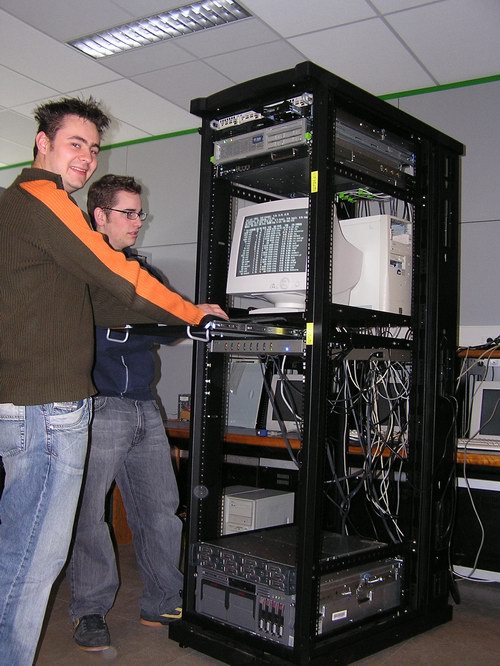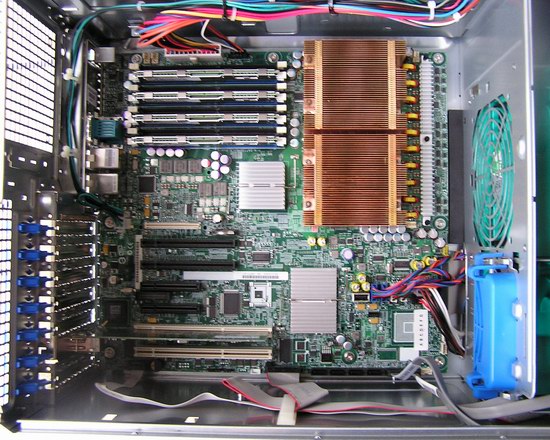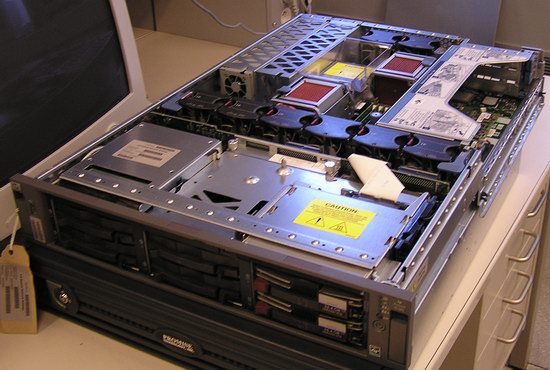Intel Woodcrest, AMD's Opteron and Sun's UltraSparc T1: Server CPU Shoot-out
by Johan De Gelas on June 7, 2006 12:00 PM EST- Posted in
- IT Computing
Words of Thanks
A lot of people gave us assistance with this project, and we like to thank them of course.
Waseem Ahmad, Intel US
Matty Bakkeren, Intel Netherlands
Trevor E. Lawless, Intel US
(www.intel.com)
Chhandomay Mandal, Sun US
Luojia Chen, Sun US
Peter A. Wilson, Sun US
(www.sun.com)
Peter Zaitsev, Elite MySQL Guru
(www.mysql.com)
Damon Muzny, AMD US
(www.amd.com)
Steve Olson, Sybase US
(www.sybase.com)
Erwin Vanluchene, HP Belgium
(www.hp.be)
Ilona van Poppel, MSI Netherlands
Ruudt Swanen, MSI Netherlands
(www.msi-computer.nl)
Alexander Goodrich, Assembler Guru
Bert Devriese, Developer of MySQL & PHP benchmark
Dieter Saeys, Gentoo/Linux support
Brecht Kets, Development of Improved Bench program
Tijl Deneut, Solaris, PostGreSQL and MySQL support
I also like to thank Lode De Geyter, manager of the University College of West-Flanders. Further information about our server research is available on our website.
Benchmark Configuration
We used Solaris 10 for the Sun T2000, as the only supported OS for the T2000 right now is Solaris 10 3/05 HW2 (and upwards). The T1 is fully binary compatibility with the existing SPARC binaries but needs this version of Solaris.
Below is a picture of our Server lab at the University College of West-Flanders. You can see Bert and Dieter standing next to our brand new rack of the server research lab.

From top to bottom, we have the Supermicro SuperServer 6014P-32, the MSI K2-102A2M, the Sun T2000, our own PIII based Linux gateway and firewall, and at the bottom, the Promise JBOD300s and the HP DL585. Yes, we still have a lot of benchmarking to do. The other Intel based machines are in towers, so you won't find them in our rack.
All benchmarking is monitored: CPU load, network and disk I/O are watched using CPU graph, top, vmstat and prstat. This way we can determine whether or not the CPU or another component is the bottleneck.
Our web server tests are performed on Apache2 2.0.55, including the mod_deflate module for gzip compression, PHP4.4.1 and Mysql 5.0.21.
Hardware Configurations
Here is the list of the different server configurations:
Sun T2000:
Sun UltraSparc T1 1 GHz, 8 cores, 32 threads
Sun Solaris 10
32 GB (16x2048 MB) Crucial DDR-2 533
NIC: 1 Gb Intel RC82540EM - Intel E1000 driver.
You can find much more information about the T1 CPU in our previous article.
Intel Server 1:
Dual Intel Xeon "Woodcrest" 3 GHz Shared 4 MB L2 cache, 1333 MHz FSB (4 cores total)

Blackford Chipset
64 bit Gentoo Kernel 2.6.15-gentoo-r7
Intel Server Board S5000
4 GB (4x1024 MB) Micron FB-DIMM Registered DDR2-533 CAS 4, ECC enabled
NIC: Dual Intel PRO/1000 Server NIC
2x Western Digital Raptor 36 GB SATA
Intel Server 2:
Dual Intel Xeon "Irwindale" 3.6 GHz 2 MB L2 cache, 800 MHz FSB - Lindenhurst
64 bit Gentoo Kernel 2.6.15-gentoo-r7
Intel Server Board SE7520AF2
8 GB (8x1024 MB) Micron Registered DDR2-400 CAS 3, ECC enabled
NIC: Dual Intel PRO/1000 Server NIC (Intel 82546GB controller)
2x Western Digital Raptor 36 GB SATA
Opteron Server 1: Dual Opteron 275 2.2 GHz 2x1MB L2 cache (4 cores total)
64 bit Gentoo Kernel 2.6.15-gentoo-r7
Solaris x86 10
MSI K8N Master2-FAR
4 GB: 4x1GB MB Crucial DDR-400 (3-3-3-6)
NIC: Broadcom BCM5721 (PCI-E)
2x Western Digital Raptor 36 GB SATA
Opteron Server 2: MSI K2-102A2M

ServerWorksHT2000 Chipset
64 bit Gentoo Kernel 2.6.15-gentoo-r7
4 GB: 4x1GB MB Crucial DDR-400 (3-3-3-6)
NIC: Broadcom BCM5721 (PCI-E)
2x Western Digital Raptor 36 GB SATA
Opteron Server 3: HP DL385

Solaris x86 10
AMD 81xx chipset
64 bit Gentoo Kernel 2.6.15-gentoo-r7
4 GB: 4x1GB MB Crucial DDR-400 (3-3-3-6)
NIC: Broadcom BCM5721 (PCI-E)
2x Seagate Cheetah 36 GB - 15000 rpm - SCSI 320 MB/s
Client Configuration: Dual Opteron 850
MSI K8T Master1-FAR
4x512 MB Infineon Registered DDR-333, ECC
NIC: Broadcom 5705
Common Software
64 bit Gentoo Kernel 2.6.15-gentoo-r7
Apache2 2.0.55 + mod_deflate module for gzip compression.
PHP4.4.1
Mysql5.0.21
A lot of people gave us assistance with this project, and we like to thank them of course.
Waseem Ahmad, Intel US
Matty Bakkeren, Intel Netherlands
Trevor E. Lawless, Intel US
(www.intel.com)
Chhandomay Mandal, Sun US
Luojia Chen, Sun US
Peter A. Wilson, Sun US
(www.sun.com)
Peter Zaitsev, Elite MySQL Guru
(www.mysql.com)
Damon Muzny, AMD US
(www.amd.com)
Steve Olson, Sybase US
(www.sybase.com)
Erwin Vanluchene, HP Belgium
(www.hp.be)
Ilona van Poppel, MSI Netherlands
Ruudt Swanen, MSI Netherlands
(www.msi-computer.nl)
Alexander Goodrich, Assembler Guru
Bert Devriese, Developer of MySQL & PHP benchmark
Dieter Saeys, Gentoo/Linux support
Brecht Kets, Development of Improved Bench program
Tijl Deneut, Solaris, PostGreSQL and MySQL support
I also like to thank Lode De Geyter, manager of the University College of West-Flanders. Further information about our server research is available on our website.
Benchmark Configuration
We used Solaris 10 for the Sun T2000, as the only supported OS for the T2000 right now is Solaris 10 3/05 HW2 (and upwards). The T1 is fully binary compatibility with the existing SPARC binaries but needs this version of Solaris.
Below is a picture of our Server lab at the University College of West-Flanders. You can see Bert and Dieter standing next to our brand new rack of the server research lab.

From top to bottom, we have the Supermicro SuperServer 6014P-32, the MSI K2-102A2M, the Sun T2000, our own PIII based Linux gateway and firewall, and at the bottom, the Promise JBOD300s and the HP DL585. Yes, we still have a lot of benchmarking to do. The other Intel based machines are in towers, so you won't find them in our rack.
All benchmarking is monitored: CPU load, network and disk I/O are watched using CPU graph, top, vmstat and prstat. This way we can determine whether or not the CPU or another component is the bottleneck.
Our web server tests are performed on Apache2 2.0.55, including the mod_deflate module for gzip compression, PHP4.4.1 and Mysql 5.0.21.
Hardware Configurations
Here is the list of the different server configurations:
Sun T2000:
Sun UltraSparc T1 1 GHz, 8 cores, 32 threads
Sun Solaris 10
32 GB (16x2048 MB) Crucial DDR-2 533
NIC: 1 Gb Intel RC82540EM - Intel E1000 driver.
You can find much more information about the T1 CPU in our previous article.
Intel Server 1:
Dual Intel Xeon "Woodcrest" 3 GHz Shared 4 MB L2 cache, 1333 MHz FSB (4 cores total)

Blackford Chipset
64 bit Gentoo Kernel 2.6.15-gentoo-r7
Intel Server Board S5000
4 GB (4x1024 MB) Micron FB-DIMM Registered DDR2-533 CAS 4, ECC enabled
NIC: Dual Intel PRO/1000 Server NIC
2x Western Digital Raptor 36 GB SATA
Intel Server 2:
Dual Intel Xeon "Irwindale" 3.6 GHz 2 MB L2 cache, 800 MHz FSB - Lindenhurst
64 bit Gentoo Kernel 2.6.15-gentoo-r7
Intel Server Board SE7520AF2
8 GB (8x1024 MB) Micron Registered DDR2-400 CAS 3, ECC enabled
NIC: Dual Intel PRO/1000 Server NIC (Intel 82546GB controller)
2x Western Digital Raptor 36 GB SATA
Opteron Server 1: Dual Opteron 275 2.2 GHz 2x1MB L2 cache (4 cores total)
64 bit Gentoo Kernel 2.6.15-gentoo-r7
Solaris x86 10
MSI K8N Master2-FAR
4 GB: 4x1GB MB Crucial DDR-400 (3-3-3-6)
NIC: Broadcom BCM5721 (PCI-E)
2x Western Digital Raptor 36 GB SATA
Opteron Server 2: MSI K2-102A2M

ServerWorksHT2000 Chipset
64 bit Gentoo Kernel 2.6.15-gentoo-r7
4 GB: 4x1GB MB Crucial DDR-400 (3-3-3-6)
NIC: Broadcom BCM5721 (PCI-E)
2x Western Digital Raptor 36 GB SATA
Opteron Server 3: HP DL385

Solaris x86 10
AMD 81xx chipset
64 bit Gentoo Kernel 2.6.15-gentoo-r7
4 GB: 4x1GB MB Crucial DDR-400 (3-3-3-6)
NIC: Broadcom BCM5721 (PCI-E)
2x Seagate Cheetah 36 GB - 15000 rpm - SCSI 320 MB/s
Client Configuration: Dual Opteron 850
MSI K8T Master1-FAR
4x512 MB Infineon Registered DDR-333, ECC
NIC: Broadcom 5705
Common Software
64 bit Gentoo Kernel 2.6.15-gentoo-r7
Apache2 2.0.55 + mod_deflate module for gzip compression.
PHP4.4.1
Mysql5.0.21










91 Comments
View All Comments
Questar - Thursday, June 8, 2006 - link
Why? Because AMD got creamed?ashyanbhog - Thursday, June 8, 2006 - link
and Intel woodcrest may have fantastic performance when compared to earlier xeons,but Intel is 3 years late to the party, Opteron was here in 2003!
also remember, woodcrest is a brand new design from PIII base, manufactured on 65nm process. It is still to make its debut in the market and be available in volumes. Amd its indeed nice to see it being compared to a 3 year old design manufactued on 90nm process.
AMD still has two product launches to come this year. Move to DDR2 for opterons which should cut some power usage for the total system AND introduction of products manufactured on 65nm at the fag end of the year. Will woodcrest and conroe still retain their performance margins then? if not, for how many months or weeks has Intel grabbed this "performance crown"?
zsdersw - Thursday, June 8, 2006 - link
Consider the following:- If comparisons could be made between new products from both companies (i.e., Woodcrest versus K8L), they would be made. In the game of leapfrog that we have betweeen AMD and Intel, the comparisons will always be between existing tech and new tech. Will you be pointing out how AMD is "late to the party" when they release their new stuff?
- Making its debut and availability in volume is an issue for both AMD and Intel. It's not a valid point unless you make it across the board.
- 65nm will allow clock speeds of Opterons/A64's to increase.. but Conroe/Woodcrest speeds will be increasing as well.
ashyanbhog - Thursday, June 8, 2006 - link
not because AMD got creamed!a 35 billion$ dollar turnover company (Intel) is bound to make a comeback one day.
it Anandtech's review setup, its full of holes
the mysql benchmark on Dual Dual core opterons where they see a 30% drop against single core dual processor numbers in this becnhmark contradicts their own earlier benchmark where they see a 10% performance increase.
http://www.anandtech.com/IT/showdoc.aspx?i=2447&am...">http://www.anandtech.com/IT/showdoc.aspx?i=2447&am...
they also use a substandard MSI motherboard in one of the Opteron systems and fail to mention which system was used for the benchmarks
mistakes like this, genuine or intentional, are rife throughout the review report
the whole thing looks like the rig was setup to push the performance diff b/w woodcrest and Opterons to the max,
why would anybody two months to tweak settings before they publish the review!
Questar - Thursday, June 8, 2006 - link
Why? Because AMD got creamed?duploxxx - Thursday, June 8, 2006 - link
yeah right its a workstation motherboard it uses an nforce controller so maybe they rate it as server board it still is a budget board used for workstations, not a real server board or server chipset like they used on the intel woodcrest.check the servers like sun galaxy and hp dl385 they have amd chipsets... big difference.
the nforce has a shared memory bus...
zsdersw - Thursday, June 8, 2006 - link
Yeah, that's one of the 3 Opteron servers. At any rate, the MSI board is a basic server board.. it's still a server board.duploxxx - Thursday, June 8, 2006 - link
yeah they have done 1 real bench with an hp. all other benches were done with the 2 MSI basic boards...still waiting for the wintel benches
wolaris - Thursday, June 8, 2006 - link
In corporate environments, no-one with any hardware budget at all runs webserver and database on the same machine, as it hurts both performance and reliability. This affects T1 most, as its low clock speed and simple cores are not meant for database workloads.I think that you should run web serving tests using common, high-performance Opteron DB server and separate webservers, as it would be the case in real-world scenarios.
MrKaz - Thursday, June 8, 2006 - link
So Power consuming of the new Intel processor on .65nm at already high clock speed of 3.0Ghz is already consuming more than the older AMD Opteron on .90nm 2.8Ghz and DDR.When AMD releases socket F will go DDR2 (less power) and better .90nm samples (lower power). So then "new" Intel is already getting beaten...
And those tests where done with Cool&Quite?
Also don’t forget this tests where done with Woodcrest 3.0Ghz VS Opteron 2.2Ghz and 2.4Ghz, so when AMD releases the 2.8Ghz and 3.0Ghz with socket F the performance lead of Intel will vanish…
I think the biggest surprise here is how bad Xeon (P4) was (IS!!), and people keep buying it.